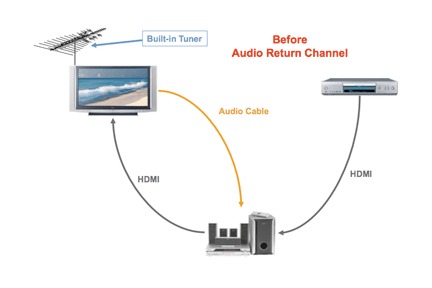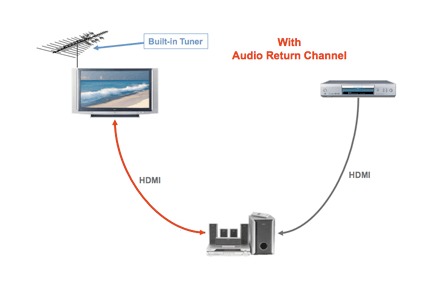
When setting up a new TV or soundbar, you’ll need various cables. Many people tend to use any old HDMI cable they have at home since most TVs are compatible with standard HDMI connections. However, if you’re installing a quality sound system with your TV, you may come across terms like HDMI ARC and eARC in the owner’s manual.
So, what is the difference between these two types of ports? Is one superior to the other? And how do they compare to standard HDMI ports?
Let’s examine HDMI ARC and eARC more closely, including comparing audio quality and the downsides of both connection types, to help you decide when to choose between them.
The HDMI superhighway
Before we delve into HDMI ARC and eARC, let’s quickly recap the purpose of an HDMI connection. HDMI (High-Definition Multimedia Interface) allows for the transmission of digital video and audio from one device to another using a single cable. Initially, this digital connection only supported one-way communication; audio and video could flow from a source device to a TV or projector, but not in the reverse direction.
The sole exception to this one-way flow was HDMI Consumer Electronics Control (CEC), which enables a limited set of commands to be sent in both directions along the HDMI cable. This feature allows a TV’s remote to control the volume of an AV receiver, or lets the power button on an AV receiver’s remote turn off the TV. It wasn’t until HDMI 1.4, a later revision of the HDMI standard, that bi-directional audio transmission became more prominent.
ARC: Audio return channel
As the name suggests, Audio Return Channel — which gives us the “ARC” in HDMI ARC/eARC — adds the ability for a TV to send audio backward along an HDMI cable to its source device. Why would you want to do that?
If you own an AV receiver, and you plug in your Blu-ray players, game consoles, or streaming device into it, the receiver will play the audio portion through your home theater speakers and send the video portion along to your TV. So far, so good.
But not every source of video you might want to watch comes from an external device. Some TVs have their own streaming apps or TV tuners. Before the advent of HDMI ARC, if you wanted to hear these sources on your receiver’s speakers instead of the ones built into your TV, you needed to run a second cable (typically an optical cable) from your TV back to your receiver. That not only destroyed the simplicity of a single-cable connection, but it also meant you needed to press some additional buttons to get things working every time you switched to using your TV as the sound source.
HDMI ARC brings that simplicity back by letting you once again use a single cable for all your needs.
Better sound

Optical cables are great for sending Dolby Digital 5.1 surround sound from device to device. However, throw a newer surround sound format at it, like Dolby Atmos or DTS:X, and it chokes. HDMI ARC, with its larger data capacity, can transmit these formats too, so if you’re using your TV to stream a Dolby Atmos title from Disney+, you’ll be able to send that signal to your compatible AV receiver or soundbar.
There is a caveat here: Even though HDMI ARC can transmit higher-bandwidth formats like Dolby Atmos, your TV still has to support these formats. For instance, some TVs will play Dolby Atmos using their built-in speakers, but they can’t pass along that same Dolby Atmos content via their HDMI ARC connection (known as Dolby Atmos passthrough). Always pay close attention to a product’s specifications to know what it can or can’t do.
Simpler switching
Normally, when using an optical connection from a TV to a receiver or soundbar, you need to manually switch to the optical input when you want to hear your TV’s sound, and then switch back to the HDMI inputs on the receiver or soundbar when you want to go back to watching an external source of content. You may also have to enable or disable your TV’s built-in speakers each time you switch.
With HDMI ARC, you can ditch your soundbar or receiver’s remotes — as soon as you start watching content that originates from your TV, your connected soundbar or receiver will automatically switch to the correct input.
eARC: Making ARC even better

HDMI ARC was a big improvement over optical audio connections, but the technology suffers from one limitation that audio purists have always bemoaned: It has the bandwidth to support Dolby Atmos, but only the lossy version of this format, which uses Dolby Digital Plus. If you’re only streaming Dolby Atmos (say from Netflix or Apple TV+), this is no big deal because that’s the same kind of Atmos that these services use.
But physical media, like Blu-ray discs or game discs for consoles, along with certain downloaded music files, use a higher quality version of Dolby Atmos thanks to the lossless, hi-res capabilities of Dolby TrueHD. There’s also the possibility that streaming services will decide to offer lossless audio as an upgrade in the future.
As you might have already guessed, Dolby TrueHD requires more bandwidth than Dolby Digital Plus, and the HDMI ARC specification was never designed to handle it. That’s why we now have enhanced Audio Return Channel (eARC), which has plenty of capacity and can handle lossless hi-res audio up to 24-bit/192kHz, which should satisfy even the most demanding audiophile.
When would I use eARC?
Right now, eARC is going to be most useful for folks who connect all of their content devices to their TV’s HDMI inputs, instead of the inputs on a soundbar or AV receiver. It’s especially handy for those who own a Dolby Atmos-capable soundbar, like the Sonos Beam (Gen-2), Sonos Arc Ultra, or Bose Smart Soundbar 900 as these speakers don’t have their own HDMI inputs.
Without an eARC port on your TV, it won’t matter if you have the most expensive Blu-ray player connected to one of its other inputs — you won’t be able to transmit hi-res, lossless audio (whether Dolby Atmos or any other format) to your external audio devices.
For people who connect their devices to an AV receiver (or a soundbar with at least one HDMI input), the need for eARC is a little less. Typical sources of high-quality audio (Blu-ray players mainly) can be plugged into this gear directly, without relying on the TV’s audio capabilities. But there’s still the chance that you’ll have a high-end audio source plugged into your TV, and at these times eARC would be handy.
So is eARC just about getting better Dolby Atmos?

No, not entirely. HDMI eARC has been designed to allow up to 37Mbps of bandwidth for the audio return channel, whereas HDMI ARC was never designed for more than 1Mbits per second. That’s a huge difference and it gives eARC the ability to pass a variety of hi-res audio formats. For instance, while Dolby TrueHD gives Atmos its best showing, TrueHD can also be used to deliver lossless versions of less exotic audio content like 5.1, 7.1, or plain-old two-channel stereo. The same thing goes for formats like DTS:X, DTS-HD, and DTS-HD Master Audio.
eARC has an automated lip-sync feature, so theoretically, you’ll no longer need to jump into delay settings on your TV or audio gear to get a perfect match of sound and picture, the way you sometimes need to do when using HDMI ARC or optical connections.
There are also some potential non-audio benefits to eARC. ARC requires HDMI-CEC to be enabled on your gear — the two work in tandem. eARC has its own built-in mechanism for device detection, which doesn’t require CEC. So while it’s still recommended to keep CEC enabled (turning it off means you won’t be able to send device commands over HDMI), if it’s causing you headaches, it might be possible to use eARC without CEC.
What equipment do I need for HDMI ARC or eARC?

For HDMI ARC, you’ll need a TV with an HDMI ARC port, and a soundbar, AV receiver, or another audio device with a corresponding HDMI ARC port. You’ll also need an HDMI cable to connect these two devices — virtually any HDMI cable will do the job as HDMI ARC is not especially demanding when it comes to bandwidth.
For HDMI eARC, it’s the same thing — both devices need an eARC port, but you’ll also need an HDMI cable that has Ethernet support, like a High-Speed HDMI cable with Ethernet, or an Ultra-High-Speed HDMI cable. As we noted above, eARC places more demands on bandwidth than ARC.
Wondering if your current gear supports HDMI ARC or eARC? If it does, there should be an “ARC” or “ARC/eARC” label on the HDMI port that supports these features.
There’s one important thing you need to be aware of: even though newer HDMI devices are designed to be backward compatible with older HDMI devices, this is not always true of eARC. Most of the time, if you connect say, an eARC TV to an ARC soundbar, you’ll still get audio from the TV — you’ll be restricted to ARC’s lower-quality audio capabilities, but it should work. But the eARC specification does not require that eARC devices are backward compatible, so there may be some instances where this doesn’t work at all. As with all technical specifications, it’s best to read the fine print and double-check with a manufacturer before buying.
Should my next TV, soundbar, or AV receiver be equipped with HDMI eARC?
In general, we’d say absolutely. HDMI 2.1 (along with HDMI eARC) are the latest standards for connecting audio and video equipment. Even if you don’t plan to take advantage of their benefits immediately, most AV purchases are going to be around for at least 10 years. That’s a long time to be stuck with something that isn’t current.
However, if you’re buying a small TV for a kitchen or bedroom, and you have no intention of ever connecting it to an external soundbar or receiver, you can probably stick with HDMI ARC (or indeed, no HDMI ARC). And if you’re buying an inexpensive soundbar for improving your TV’s sound, and you don’t care about Dolby Atmos, hi-res audio, or future-proofing, then that device is probably fine without ARC or eARC too.
Are there any downsides to using ARC/eARC?
If you have devices that support it, there are really no downsides to using the technology, especially the advanced version of eARC, which helps guarantee there won’t be any audio downgrades, and may even allow you to gain other HDMI 2.1 benefits that you couldn’t via other connections. Cable management is easier, too. It’s also relatively easy to find ARC and eARC devices these days — Best Buy has a whole search filter for it, for example.
To reap the benefits of ARC/eARC, all of your gear will need to support it, which could mean a pretty big investment on your part. But it’s possible to do it in stages. If you really like your TV, for instance, but it doesn’t have HDMI ARC/eARC, here’s an option: Buy a soundbar that has an HDMI input, an optical input, and an HDMI output.
This lets you rig up a system that sends full-quality sound from a streaming device like an Apple TV 4K to your soundbar, which in turn sends just the video to your TV. Any audio that your TV produces will still get sent to the soundbar over the optical connection. That audio will be limited to Dolby Digital 5.1 sound, but if your TV doesn’t have HDMI ARC/eARC, then that’s likely the best sound your TV can produce anyway.
You should also start counting your HDMI ports, as some home theater setups may not have room for your ARC/eARC connections. A common example is connecting an ARC-supporting soundbar that doesn’t have an HDMI input, only an output. That means your TV needs to use an HDMI ARC/eARC port just for sound. If you are already juggling several HDMI connections, your TV may not have enough ports necessary for this kind of setup.
I’ve also heard about HDMI 2.1 — is this the same thing?

The answer is both yes and no; it’s complicated.
HDMI 2.1 is the latest version of the HDMI specification, which outlines the technical requirements that manufacturers must follow to implement HDMI 2.1 in their devices. It’s important to note that HDMI eARC is one of the many features included in HDMI 2.1. However, things get a bit confusing.
Manufacturers have the flexibility to choose which features of HDMI 2.1 they want to support. They can opt to include all the features, only a select few, or any combination thereof. As a result, they are still allowed to claim that their products offer HDMI 2.1, which can be quite misleading. Surprisingly, eARC is considered an optional feature, similar to how ARC was viewed in previous HDMI versions.
To complicate matters further, it’s possible to enable HDMI eARC using non-HDMI 2.1 chipsets. This means that a TV could have eARC functionality while not incorporating any other HDMI 2.1 features.
If you’re interested in a detailed explanation of HDMI 2.1 and what it has to offer (hint: it’s primarily aimed at gamers and users of 8K TVs), we have an informative guide available. For now, the key takeaway is this: If you want a device that supports HDMI eARC, make sure to look for that exact label on the product box, within the specifications, or on the HDMI port labels (fortunately, HDMI ports are clearly labeled for this purpose).
Apple TV 4K

The vast majority of folks will use ARC/eARC between their TVs and soundbars or AV receivers, but there is one unusual case that’s worth mentioning. The latest Apple TV 4K models also have HDMI eARC (even though the HDMI port isn’t labeled with eARC), which is bizarre if you think of it just as a streaming media device. But because you can wirelessly connect Apple’s HomePods or HomePod Minis to this Apple TV to act as your home theater speakers, Apple’s little black box can now act as a kind of hybrid streamer/receiver, letting you listen to any content the Apple TV can play as well as any audio your TV can generate.





